What Risk Factors Are Identified With Juvenile Crime?
As we noted earlier, a relatively small number of juveniles commit crime. Furthermore, of those juveniles who do commit crimes, the majority of them will only commit one or two offenses. For these individuals, the experience of the juvenile justice system--being arrested by a law enforcement officer, facing their parents, having to spend a night in juvenile hall, interacting with a probation officer or a judge--is enough to keep them from offending again.
Nevertheless, a small number of individuals who are chronic recidivists are responsible for a large proportion of juvenile crime. Much research has shown that these juveniles commit their fist offense at an early age (usually age 11), and even at this early age, these juveniles display a variety of serious problems indicative of an "at-risk" juvenile:
- Failure in School. This factor manifests itself at an early age. Failure at school includes poor academic performance, poor attendance, or more likely, expulsion or dropping out of school. This is an important factor for predicting future criminal behavior. Leaving school early reduces the chances that juveniles will develop the "social" skills that are gained in school, such as learning to meet deadlines, following instructions, and being able to deal constructively with their peers.
- Family Problems. This factor includes a history of criminal activity in the family. It also includes juveniles who have been subject to sexual or physical abuse, neglect, or abandonment. It is also manifested by a lack of parental control over the child.
- Substance Abuse. This risk factor includes not just arrests for drug or alcohol possession or sale, but also the effect of substance abuse on juvenile behavior. For example, using alcohol or drugs lowers a person's inhibitions, making it easier to engage in criminal activity. Also, drug abuse can lead to a variety of property offenses to pay for drug habits.
- Pattern Behaviors and "Conduct" Problems. Pattern behaviors include chronic stealing or running away. Juveniles with "conduct" problems can be character-ized as those individuals who have not outgrown aggressiveness by early adolescence.
- Gang Membership and Gun Possession. Gang membership and gang-related crime is primarily a juvenile problem. Gang membership, especially at an early age, is strongly associated with future criminal activity. Juvenile gun possession is a factor that "magnifies" juvenile crime by making offenses more likely to result in injury or death.
Having these risk factors does not guarantee criminal behavior, but simply increases the likelihood of such behavior. Because young offenders who exhibit multiple risk factors are the most likely to become chronic recidivists--"career criminals"--early intervention that alleviates these problems could potentially have a long-term beneficial impact on the level of future crime.
What Do We Know About Risk Factors for California? Some data are available that provide a picture of what is happening in California for most of the major risk factors. The following charts provide information on some of these risk indicators. We also point out information that is not being gathered which, if it were available, could facilitate decision making.
California's Eighth-Grader Math Scores Below Comparison States
1992

- The education scores of California's eighth-grade students from disadvantaged urban areas--metropolitan areas in which a high proportion of studet's parents are on welfare or are not regularly employed--are lower than similar students in comparison states. California's fourth graders also show poor performance in contrast to other states.
- Low performance for these age groups does not necessarily mean that students will fail in school and go on to criminal behavior, but it is indicative of a large population with the risk indicator.
- California and New York have the highest percentage of students from urban disadvantaged areas.
Students Expelled or Suspended In Six School Districts
1992-93
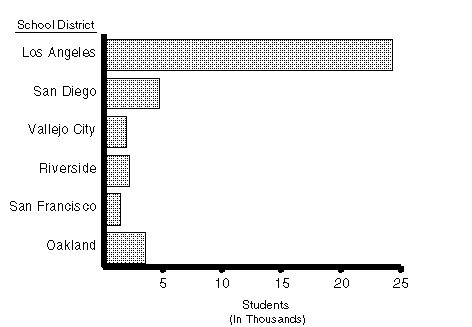
- Out of a total 900,838 students in these six school districts, 37,722, or 4.2 percent, were expelled or suspended in 1992-93. The expulsions/suspensions were for fighting (the primary reason), weapons possession, drugs, or robbery.
- The expulsions/suspensions ranged from 9.9 percent of the students for Vallejo schools to 2.3 percent of the students for San Francisco schools. In Los Angeles, 24,236 students (3.9 percent) were expelled or suspended, 20,854 for fighting. For all six school districts combined, about 10 percent of the students expelled or suspended were for possession of weapons.
- Neither the state nor school districts routinely collect expulsion/suspension data. (The data in this figure are from a special 1994 survey.) Furthermore, neither schools nor the state have data on the number of truant students. Consequently, there is no statewide data on the number of at-risk students who do not regularly go to school.
Significant Number of Students Drop Out by Ninth Gradea
1992
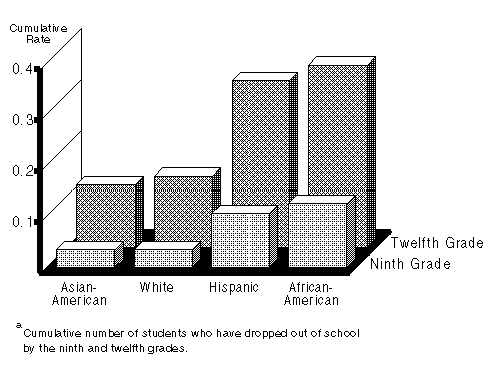
- By the end of the ninth grade, 11 percent of African-American and Hispanic youths and 3.5 percent of white and Asian-American youths, have dropped out of school. Leaving school at age 14 (approximately the ninth grade) increases the difficulty of these youth finding work which will provide an adequate income.
- While California's overall dropout rates are declining, the state's rates are still higher than the national average.
Emergency Responses to Reports of Child Abuse Are Increasing
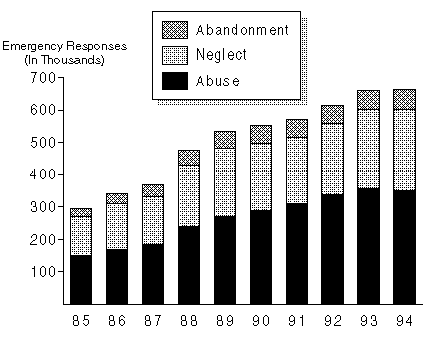
- In 1994, county child welfare services staff responded to 664,294 reports of abuse (sexual, physical, emotional, and exploitation), neglect (serious and general), and abandonment. This is a 125 percent increase over the number of emergency responses in 1985. The number of responses has increased at an average annual rate of almost 10 percent.
- Research, particularly that looking at the origins of violence, suggests that individuals who are subjected to abuse, neglect, or abandonment are much more likely to be violent themselves than those who have not experienced such treatment. In addition, those subject to sexual abuse are more likely to commit crimes as adults, including sex crimes.
Out-of-Wedlock Births Are Increasing
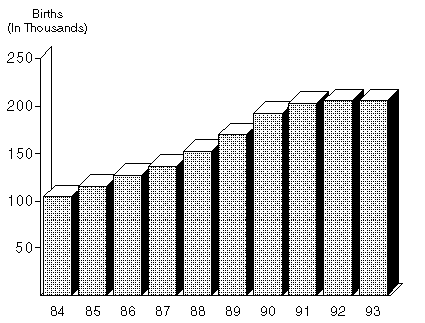
- Out-of-wedlock births in California increased by 97 percent between 1984 and 1993.
- The out-of-wedlock births occur primarily in single parent families, usually with minimal financial resources.
Many Juveniles Arrested for an Offense
Also Test Positive for Drugs
1993
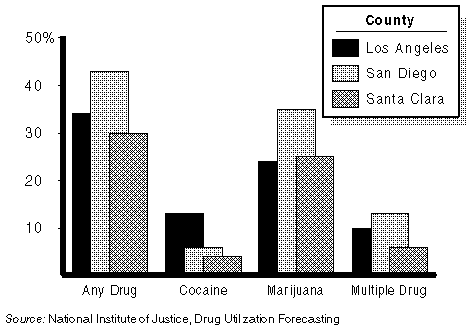
- In 1993, 30 percent to 43 percent of the juveniles arrested for an offense also tested positive for drug use in the three counties that participated in the federal Drug Utilization Forecasting program. This federal program randomly tests juvenile and adult arrestees in major metropolitan areas to track drug trends.
- These juveniles were arrested for crimes ranging from vandalism to murder. Since collecting these data starting in 1990, the rate of positive tests has gone up 10 percent.
- Alcohol also is an important factor in juvenile crime. The American Psychological Association's report Violence and Youth reported that alcohol was a major factor in youth violence because alcohol lowers inhibitions against violent behavior. The report also noted that violence frequently occurs in places where alcohol is consumed. Furthermore, in 65 percent of all homicides, the perpetrators, victims, or both had been drinking. The report also stated that alcohol is a factor in 55 percent of fights and assaults in the home.
California Cities Reporting Gang Activity
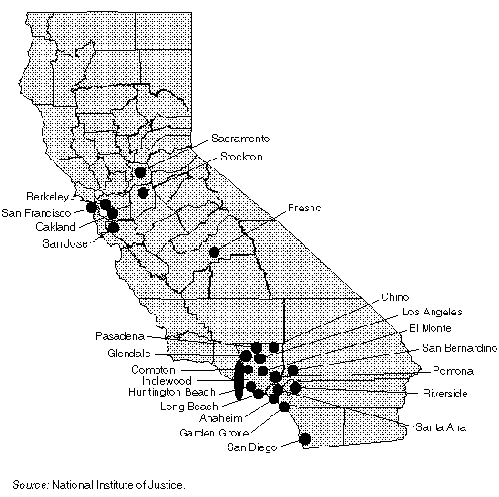
- Gang-related crime is often a violent crime problem. Nationwide, homicides and other violent crimes account for half of all recorded gang-related crimes. In California, gang-related homicide is not accounted for separately, but it is estimated that approximately 25 percent of California homicides are gang-related.
- The Los Angeles Police Department (LAPD) reported 503 gangs in its jurisdiction with over 55,000 identified members. The LAPD also reported 8,528 gang-related crimes.
Nationwide Profile of Juvenile Gun Possession and Use
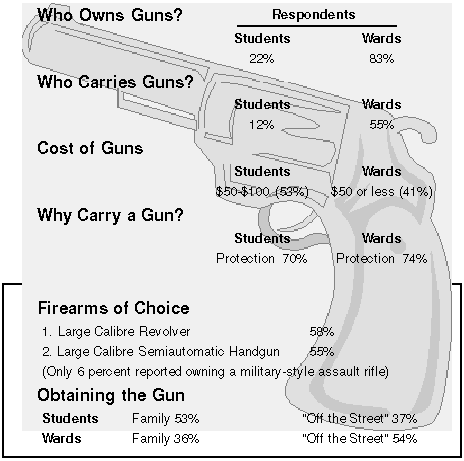
- Data for this profile was prepared by the National Institute of Justice, where researchers interviewed students in large urban high schools and juveniles (wards) in detention facilities in four states, including California.
- The data show that as many as one in eight students carry a weapon to school, that the weapons are easily obtained, and inexpensive.
- The research found that in addition to carrying guns for protection, wards reported that 63 percent had committed crimes with guns; 40 percent had obtained a gun specifically for use in a crime.
Return Juvenile Crime Table of Contents
Visit the 2007 Publication, California’s Criminal Justice
System: A Primer
Return to LAO Home Page